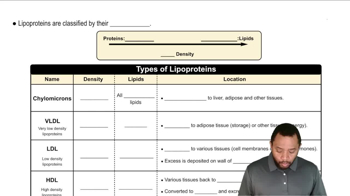Here are the essential concepts you must grasp in order to answer the question correctly.
Lipoproteins
Lipoproteins are complex particles composed of lipids and proteins that transport lipids through the bloodstream. They vary in density and function, with different types responsible for carrying specific lipid types. Understanding the role of lipoproteins is crucial for distinguishing between those that transport dietary (exogenous) lipids and those that carry lipids synthesized by the body (endogenous).
Recommended video:
Lipoproteins for Transport Concept 2
Exogenous vs. Endogenous Lipids
Exogenous lipids are those obtained from dietary sources, while endogenous lipids are produced by the body through metabolic processes. This distinction is important in understanding how different lipoproteins function, as certain lipoproteins are specifically designed to transport lipids from food, while others manage lipids generated internally, impacting overall lipid metabolism and health.
Recommended video:
Intro to Lipids Example 1
Chylomicrons and LDL
Chylomicrons are a type of lipoprotein that primarily transport exogenous lipids, such as triglycerides from dietary fats, from the intestines to other tissues. In contrast, low-density lipoprotein (LDL) is responsible for transporting endogenous lipids, particularly cholesterol, from the liver to peripheral tissues. Recognizing the specific roles of these lipoproteins is essential for understanding lipid transport mechanisms in the body.
Recommended video:
Lipoproteins for Transport Concept 2
 Verified Solution
Verified Solution



 1:39m
1:39m
